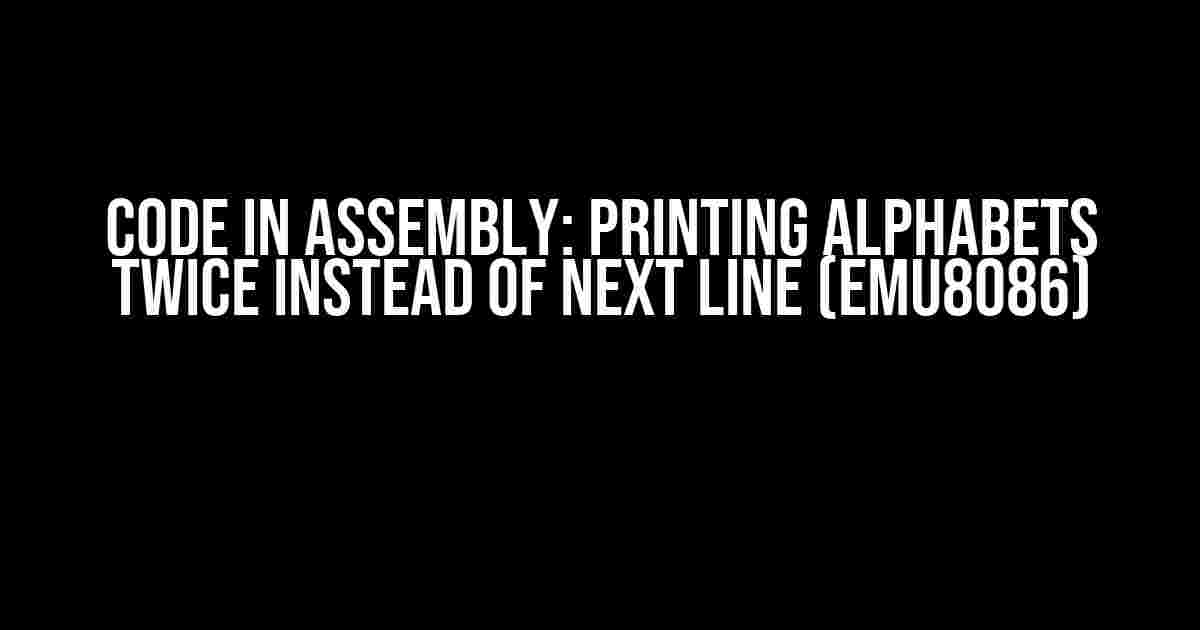Introduction
Welcome to this comprehensive guide on coding in assembly language using emu8086! In this article, we will explore a unique problem that might have you scratching your head: printing alphabets twice instead of moving to the next line.
The Challenge
When working with assembly language, printing alphabets might seem like a straightforward task. However, things can get tricky when you want to print the same alphabet twice in a row, without moving to the next line. This is especially true when using emu8086, a popular emulator for 8086 microprocessors.
Understanding the Basics
- Assembly Language: A low-level, symbolic representation of machine code.
- emu8086: An emulator for 8086 microprocessors, allowing you to run assembly code on your computer.
- Registers: Small amounts of memory built into the CPU, used to store and manipulate data.
- Instructions: Operations that the CPU performs on data, such as moving, adding, and printing.
The Problem
When trying to print alphabets twice in a row using emu8086, you might encounter an issue like this:
.model small
.stack 100h
.data
msg db 'A$'
.code
mov ax, @data
mov ds, ax
mov ah, 09h
lea dx, msg
int 21h
mov ah, 09h
lea dx, msg
int 21h
end
This codesnippet prints the alphabet ‘A’ twice, but with a newline character in between:
A
A
The Solution
To print the alphabets twice in a row, without moving to the next line, we need to modify our approach. Here’s the corrected code:
.model small
.stack 100h
.data
msg db 'A$'
.code
mov ax, @data
mov ds, ax
mov ah, 09h
lea dx, msg
int 21h
mov ah, 02h
mov dl, [msg]
int 21h
end
Let’s break it down:
- The first part of the code remains the same, printing the alphabet ‘A’ using the `int 21h` instruction with `ah = 09h`.
- The second part uses the `int 21h` instruction with `ah = 02h` to print a single character.
- We load the character ‘A’ into the `dl` register using `mov dl, [msg]`.
- Then, we print the character using `int 21h` with `ah = 02h`.
This will output:
AA
Why Does It Work?
The key to this solution lies in understanding the difference between `int 21h` with `ah = 09h` and `ah = 02h`:
| Value of AH | Function |
|---|---|
| 09h | Prints a string terminated by ‘$’ |
| 02h | Prints a single character |
When we use `int 21h` with `ah = 09h`, it prints the entire string, including the newline character, which is why we see the alphabet ‘A’ printed twice with a newline character in between.
By using `int 21h` with `ah = 02h`, we can print a single character without the newline, allowing us to print the alphabet ‘A’ twice in a row.
Tips and Variations
Now that you’ve mastered printing alphabets twice in a row, here are some additional tips and variations to take your skills to the next level:
Printing Multiple Alphabets
To print multiple alphabets twice in a row, simply modify the data segment:
.data
msg db 'ABC$'
This will output:
ABCABC
Using Loops
You can use loops to print alphabets multiple times:
.model small
.stack 100h
.data
msg db 'A$'
.code
mov ax, @data
mov ds, ax
mov cx, 5 ; print 5 times
loop_start:
mov ah, 09h
lea dx, msg
int 21h
mov ah, 02h
mov dl, [msg]
int 21h
loop loop_start
end
This code will output:
AAAAA
Conclusion
In this comprehensive guide, we’ve explored the challenge of printing alphabets twice in a row using emu8086. By understanding the basics of assembly language, registers, and instructions, we were able to craft a solution that uses `int 21h` with `ah = 02h` to print a single character without a newline.
Remember to practice and experiment with different variations to solidify your skills. Happy coding!
Frequently Asked Question
Are you stuck with your assembly code printing alphabets twice instead of moving to the next line in emu8086? Worry not, we’ve got you covered! Here are some frequently asked questions and answers to help you debug your code:
Why is my assembly code printing alphabets twice instead of moving to the next line?
This might be happening because you’re not incrementing the DH register (data segment address) after printing each alphabet. Try incrementing DH after each iteration to move the cursor to the next position.
How do I move the cursor to the next line in emu8086?
To move the cursor to the next line, you need to reset the DL register (data segment offset) to 0 and increment the DH register. This will move the cursor to the beginning of the next line.
What is the purpose of the DH and DL registers in emu8086?
In emu8086, the DH register holds the page number (segment address) and the DL register holds the column number (offset) for the cursor position. Together, they determine the position of the cursor on the screen.
How do I print a newline character in assembly language using emu8086?
To print a newline character, you can use the ASCII code 0DH (carriage return) followed by 0AH (line feed). This will move the cursor to the beginning of the next line.
What is the difference between a carriage return (CR) and a line feed (LF) in assembly language?
A carriage return (CR) moves the cursor to the beginning of the current line, while a line feed (LF) moves the cursor to the next line. In emu8086, using both CR and LF together is necessary to move the cursor to the beginning of the next line.

